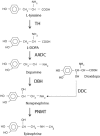Clinical Description
Dopamine beta-hydroxylase (DBH) deficiency is characterized by a lack of sympathetic noradrenergic function resulting in profound deficits in autonomic regulation of cardiovascular function and other autonomic dysfunction. Most individuals have abnormal kidney function, and some have joint laxity, hypotonia, high-arched palate, anemia, and/or hypoglycemia (in childhood). To date, only about two dozen individuals have been reported with a pathogenic variant in DBH. The following description of the phenotypic features associated with this condition is based on these reports.
Table 2.
Dopamine Beta-Hydroxylase Deficiency: Frequency of Select Features
View in own window
| Feature | Proportion of Persons w/Feature 1 |
|---|
|
Abnormal cardiovascular regulation
| Severe orthostatic hypotension | 21/21 |
| Postprandial hypotension | 3/7 |
| Epileptiform symptoms | 4/12 |
| EKG abnormalities | 2/12 |
|
Other autonomic dysfunction
| Nasal stuffiness | 10/10 |
| Ptosis | 12/14 |
| Sleep irregularities | 5/7 |
| Impaired ejaculation | 4/4 |
|
Kidney manifestations
| Increased BUN | 6/9 |
| Increased plasma creatinine | 6/11 |
| Polyuria/nocturia | 3/9 |
|
Neuromuscular manifestations
| Joint laxity | 6/10 |
| Muscle hypotonia | 3/9 |
| Sluggish deep tendon reflexes | 3/9 |
|
Other
| High-arched palate | 9/10 |
| Anemia | 9/15 |
| Hypoglycemia in infancy | 4/12 |
BUN = blood urea nitrogen
- 1.
Number of individuals with the finding / total number evaluated for the finding
Onset. Although DBH deficiency appears to be present from birth, the diagnosis is not generally recognized until late childhood, when orthostatic hypotension becomes more severe. Infants can present with ptosis, vomiting, dehydration, hypotension, hypothermia, and hypoglycemia requiring repeated hospitalization. Symptoms worsen in late adolescence with profound orthostatic hypotension, fatigue, greatly reduced exercise tolerance, ptosis, and nasal stuffiness.
Syncope and exercise intolerance. Presyncopal symptoms include dizziness, blurred vision, dyspnea, nuchal discomfort, and occasionally chest pain. These symptoms may worsen in hot environments or after heavy meals or alcohol ingestion.
Children with DBH deficiency have recurrent syncope and markedly reduced exercise capacity. Symptoms worsen in late adolescence with profound orthostatic hypotension, fatigue, and greatly reduced exercise tolerance.
Other autonomic dysfunction. Ptosis is common in individuals with DBH deficiency and can be noted at an early age. Delay in opening of the eyes has occurred in infancy, and ptosis is seen in most affected infants. Nasal stuffiness is prevalent. Males experience retrograde or prolonged ejaculation.
Kidney function. Most individuals have mildly elevated blood urea nitrogen and plasma creatinine by the time the diagnosis is made. It has been proposed that the cause of this mild but consistent kidney impairment is related to the repeated hypotension or the high renal levels of dopamine, but an underlying cause has not been determined. Kidney function does not seem to improve with droxidopa therapy [Wassenberg et al 2021] (see Management, Targeted Therapy).
High palate. Physicians who inspect the palate often report that individuals with DBH deficiency have a high-arched palate [Man in 't Veld et al 1988; Cheshire et al 2006; E Garland, unpublished data]. This, however, is generally a subjective determination; it is not known how frequently it is either not assessed or reported incorrectly.
Hypoglycemia. Because so few individuals have been diagnosed with DBH deficiency, there has not been a clear explanation for the occurrence of hypoglycemic episodes in some infants. It is not known if this is related to the absence of norepinephrine and epinephrine or the elevated levels of dopamine. Investigators have speculated that it may result from loss of the counterregulatory actions of epinephrine that protect against hypoglycemia [Man in 't Veld et al 1987]. In contrast to the reports of hypoglycemia during the perinatal period, a girl age 15 years studied with a hyperglycemic clamp had a normal fasting glucose level but insulin resistance [Arnold et al 2017]. Her hyperinsulinemia persisted after a year of droxidopa treatment, despite improved orthostatic tolerance and restoration of plasma norepinephrine [Arnold et al 2017].
Cognitive function. Despite the lack of norepinephrine, persons with DBH deficiency have relatively normal mental status.
Five affected individuals and ten matched healthy unaffected participants underwent a comprehensive battery of neurocognitive testing in addition to brain MRI, pupillometry, and EEG. Performance of the affected individuals, whether on or off droxidopa treatment, was similar to that of the unaffected individuals in most respects, suggesting that other systems compensate for absent norepinephrine in affected individuals.
Brain MRI studies revealed a smaller total brain volume in the affected individuals compared to unaffected individuals, although relative proportions of white and gray matter and cerebrospinal fluid were similar in the two groups.
In addition, affected individuals had a temporal attention deficit when they were not on treatment. During an attentional blink task, participants were asked to identify two digits, separated by a variable number of letters. Attentional blink refers to the deficit in processing the second digit when it is presented within 200-400 msec of the first. Accuracy in identifying the second digit was impaired in affected individuals not on treatment, but performance improved with droxidopa treatment [
Jepma et al 2011].
Prognosis. There are no systematic follow-up studies that can help define the prognosis of this disorder. Some individuals die in infancy, possibly related to hypoglycemia. A few anecdotal cases of premature death have been reported [Wassenberg et al 2021].
One individual was not diagnosed with DBH deficiency until age 73 years despite having long-lasting orthostatic hypotension [Despas et al 2010], suggesting that DBH deficiency may not necessarily shorten life span.


